14 February 269
"He was apprehended, and sent by the emperor [Claudius II] to the perfect of Rome, who, on finding all his promises to make him renounce his faith ineffectual, commanded him to be beaten with clubs, and afterwards to be beheaded, which was executed on February 14, about the year 269. Pope Julius I is said to have built a church near Ponte Mole to his memory, which for a long time gave name to the gate now called Porta della Popolo, formerly Porta Valentini."
14 February 1778 Saturday
Vases, Candelabra, Grave Stones, Sarcophagi. Tripods, Lamps and Ancient Ornaments volume I
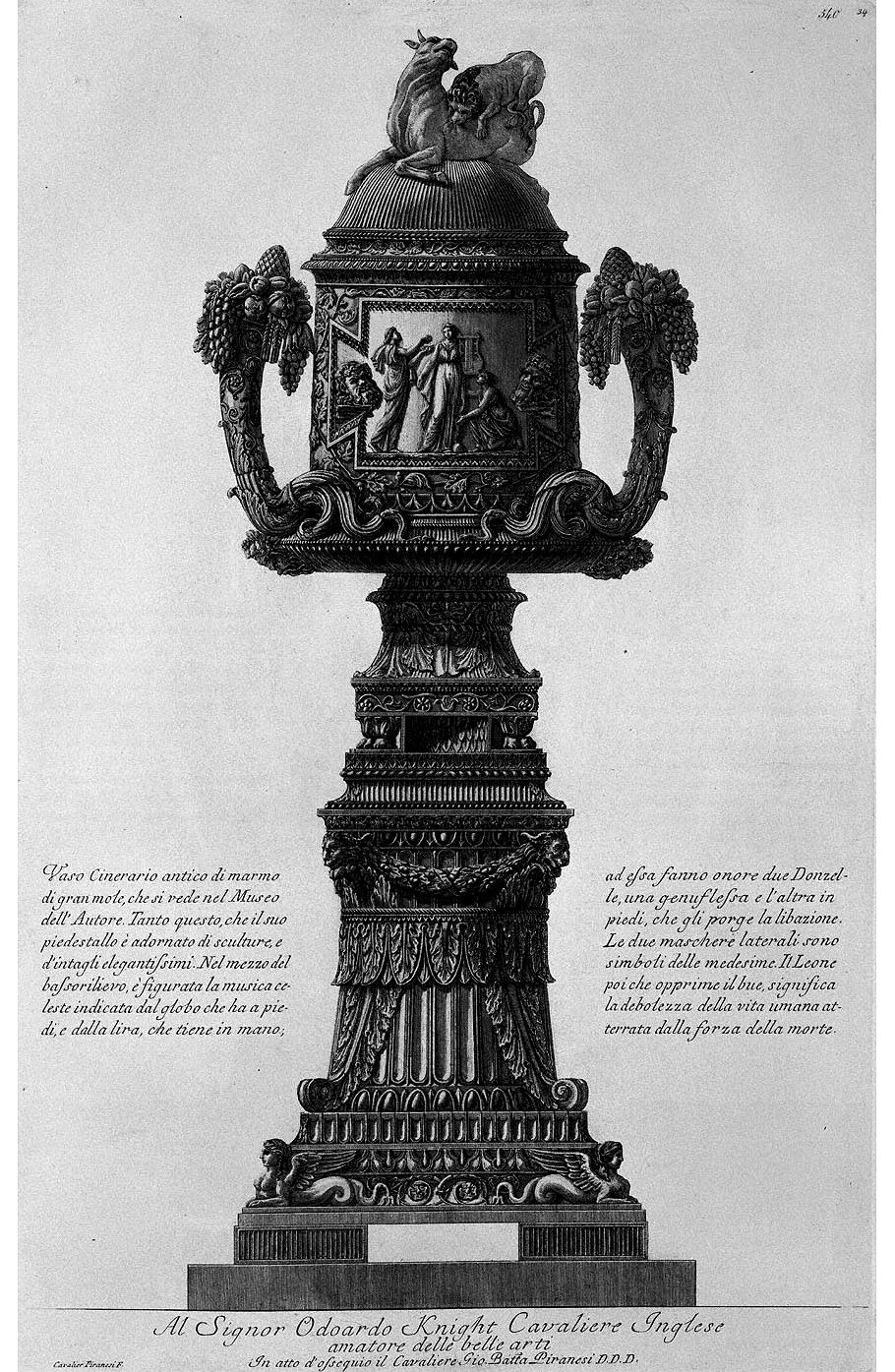
To Mr. Odoardo Knight English Knight lover of the fine arts
In deed of respect the Knight Gio Batt(ist)a Piranesi D. D. D.
Ancient marble cinerary vase of great size, which can be seen in the Author's Museum. So much so that its pedestal is adorned with sculptures and very elegant carvings. In the middle of the bas-relief celestial music is depicted, indicated by the globe which he has at his feet, and by the lyre which he holds in his hand; it is honored by two Maidens, one kneeling and the other standing, who offers him the libation. The two side masks are symbols of the same. The Lion then oppressing the ox, signifies the weakness of human life overthrown by the force of death.
Cavalier Piranesi F.
14 February 1812 Friday
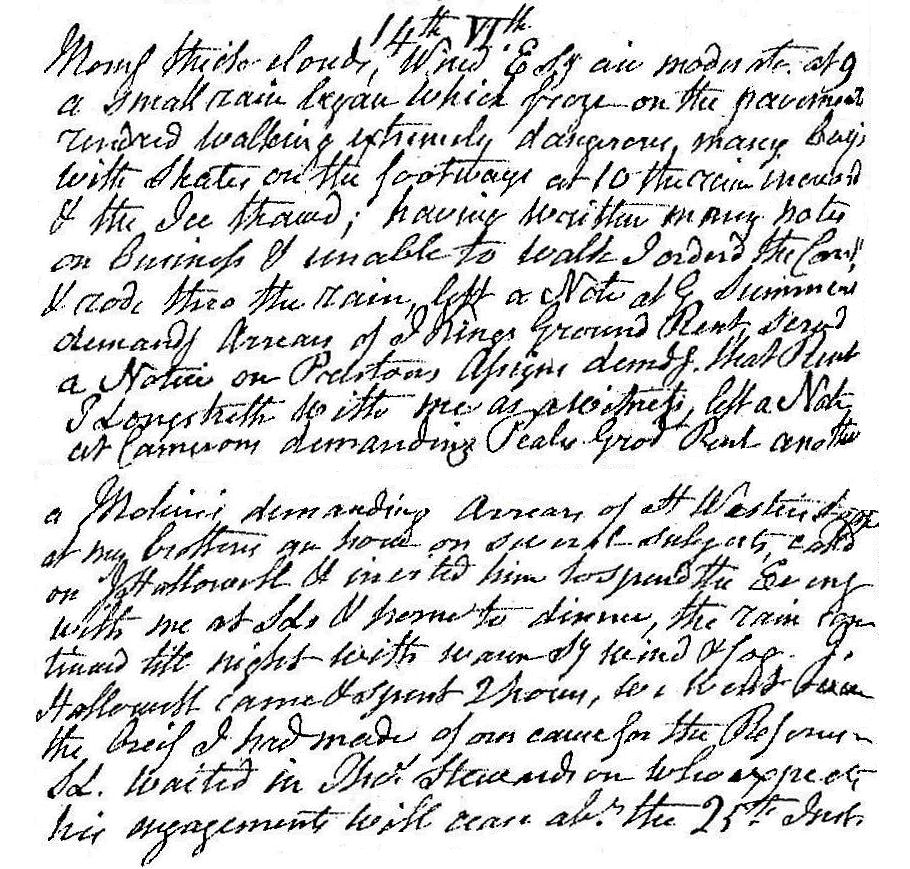
Morning thick clouds, wind ESerly, air moderate. At 9 a small rain began which froze on the pavements, rendered walking extremely dangerous, many boys with skated on the footways. At 10 the rain increased and the ice thawed; having written many note on business and unable to walk I ordered the carriage and rode thru the rain, left a note at G. Summer's demanding arrears of I. King's ground rent, served a notice on Prelators[?], Assigns[?] demanding that rent, T. Longstreth with me as a witness, left a note at Cameron's demanding Peale's ground rent, another at Molinari[?] demanding arrears of H. Westin's[?] ... at my brother's an hour on several subjects, called on J. Hallowell and invited him to spend the evening with me at SL's and home to dinner. The rain continued the night with warm Serly wind and fog. J. Hallowell came and spent 2 hours. We went over the brief I had made of our course[?] for the reform[?]. SL waited in Theo[?] Steward's on who expects his arrangements will cease about the 25th I....[?].
14 February 1983
It's Monday, and I'm at Intergraph headquarters in Huntsville, Alabama; the Space Shuttle was designed and drawn here. I'm here for eight days of CAD training, sent by Cooper & Pratt Architects of Philadelphia. I've been working as an (un-licensed) architect for just over a year, and next month I'll be 27 years old. I already know that the time I spend at Intergraph has the capacity to change the direction of my life.
Training started in a windowless classroom; oh what a joy. Bernie (my co-worker from Philadelphia) and I are the youngest trainees; the rest (about 8) are older architects, heads of their own firms; they all wondered why our employers chose to send the relatively inexperienced two of us. Right away we received several manuals in fully loaded binders; it's exhausting just looking at those things. Nevertheless, I manage to pay somewhat close attention to what is being taught, but really only looking forward to the first hands-on session scheduled for the second part of the afternoon class.
Two 14" monitors, floating command menu, 12-button cursor, large digitizing table. Blank screens can be, I find out, just as intimidating as the proverbial blank sheet of paper. After testing most of the basic drawing commands I notice that some of the other's monitors have point grids on the screen. I ask the TA watching me from behind how I can do that; he quickly showed how to turn the grids on and off and how to customize the grid to whatever module I wanted. Having a point of reference is suddenly the key that unlocks it all. So, what's my first CAD drawing going to be?
Through of an essay on geometry I'd written in 1979, I knew Palladio's plan of the Villa Rotunda followed a geometry of concentric circles within squares. If I got the circles/squares on the screen, then I could easily and accurately draw the plan of the Villa Rotunda from memory. I was the first in the room to have an actual whole plan on the screen. Upon seeing it, one of the older architects kind of jealously asked, "So, does your office do classical architecture or something?" I had to stop myself from laughing, but still thought, "What an idiot."
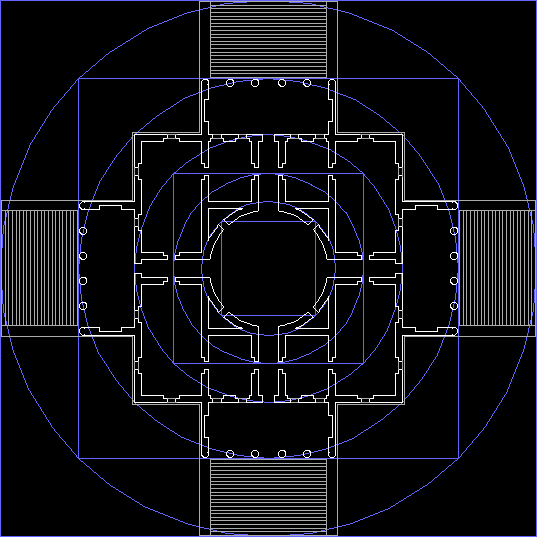
A much more precise reenactment.
14 February 2004
Re: of castles, fortifications, etc.
Mecca and WTC, what a comparison. You seem to be asking (and answering) "how does one design a site of pilgrimage well?" I agree that this is an apt question for design these days. Lucky for me, I suppose, my 'pilgrimage' to the post 9-11 WTC occurred the first weekend Lower Manhattan was reopened after the attack. A true once in a lifetime event. I haven't visited the Pentagon or Shanksville yet, however.
Architect Aldo Rossi also held the lighthouse typology in high regard. If you are not familiar with his many architectural sketches (many of which are published in a fair number of books), you might find lots of inspiration related to your own work. His collecting of favorite typologies is much akin to your own collecting of the 'architecture of electricity'.
Last evening Philadelphia was witness to a great 100' to 150' column of fire. Ten minutes before 5 o'clock a small crew of water workers at the intersection of Olney and Ogontz Avenues (about 2.5 miles directly west from where I live) accidentally broke open a 20" gas main, and within a half minute there erupted an enormous explosion resulting in a tremendously powerful vertical jet of flame. Miraculously, no one was injured, and after four hours the pressure within the gas main was shut off, and the column of fire was gone.
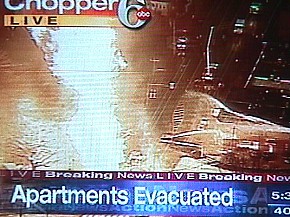
Your thoughts about the place of fiction in the reality of modern life is poignant. Late last night I watched the movie (based on the book) Remains of the Day, and it's story seems to relate to what you say.
From amazon.com: "The novel's narrator, Stevens, is a perfect English butler who tries to give his narrow existence form and meaning through the self-effacing, almost mystical practice of his profession. In a career that spans the second World War, Stevens is oblivious of the real life that goes on around him--oblivious, for instance, of the fact that his aristocrat employer is a Nazi sympathizer. Still, there are even larger matters at stake in this heartbreaking, pitch-perfect novel--namely, Stevens' own ability to allow some bit of life-affirming love into his tightly repressed existence."
What I saw in the film is that the aristocrat employer was just as oblivious as his butler, an oblivion, moreover, manifest by grandly organized pretense. In the movie, Christopher Reeves plays a U.S. Congressman from Pennsylvania. Before he visits the manor for a circa 1936 foreign affairs conference, the aristocrat and some of his compatriots wonder as to the source of the Congressman's family's wealth--"Perhaps they made their money from trolley cars." This is an obscure reference to the Philadelphia Wideners, for whom Lynnewood Hall by Horace Trumbauer was built.
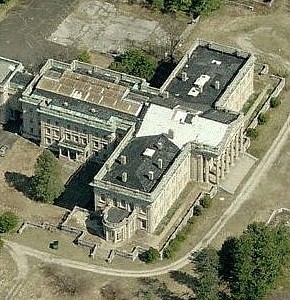
Horace Trumbauer, Lynnewood Hall (Elkins Park, PA: 1898-1900).
I spent the better part of yesterday afternoon (just across the street from the now derelict Lynnewood Hall, which was once just as grand as the Manor House in the movie) at Our Lady of Prouille, the quondam Elstowe, estate of the Elkins Family, now a retreat house run by the Dominican Sisters of St. Catherine de Ricci. I had the good fortune of speaking with Sister Caroline who is now in charge of the place. We even discussed Louis Kahn's unexecuted design for a Motherhouse which the Sisterhood had commissioned. Before going home, I went to the art library at Temple University's Tyler School of Art (which is right next to where I spoke with Sister Caroline, whose office is within what used to be the estate squash courts). Because I was looking up books about the art treasures that used to be within Lynnewood Hall (now the Widener Collection within the National Gallery, Washington DC), the librarian also brought out of the rare book room a most unexpected item--the 1946 auction catalogue of the estate of Eva Stotesbury.
Gosh, I love the reality of fabricating a novel/fiction.
14 February 2006
non-event cities
Are "events" now-a-days actually well masked advertisements?
Is "history" now-a-days a record of well masked advertisements?
Are "non-event cities" now-a-days the bulk of reality?
Is there a reality to "architect as event planner?"
non-event cities
There used to be many stores in Philadelphia just like I. Goldbergs. The quondam Bond Linen on 5th Street in Olney was exactly like I. Goldbergs, except for bedding, etc. And I wonder how many people still remember South Street before it became "South Street"--I still vividly remember going shopping there with my parents for a leather coat for my brother back in the late sixties--there were several blocks of men's clothing stores, and the salesmen would literally grab you on the sidewalk and drag you into the store. Quite the 'event'.
non-event cities
When I was very little, probably in 1960, about once a month on Friday nights my parents would take me and my brother to "the south." I can still vividly remember my first trip there because it seemed like we went to Hell. We were first greeted by multiple barrels in the street with open flames coming out their tops, and lots of noise and smells and trash everywhere, and there were dead animals all over the place, I mean dead fish and dead rabbits and dead chickens, and I got really afraid when I saw my father going into a big dark room with dead pigs and cows hanging in it. Of course, my older brother was no help because he made me touch the dead animals as we walked by them.
After several trips my brother and I put up such a fuss that we were allowed to stay home, and I never wanted to go to "the south" again.
Fifteen years later in my first year of architecture school, the teachers wanted us students to learn and experience the city, "and everyone should go to the Italian Market in South Philadelphia, it's vibrant and lively."
14 February 2013
Log 26 came in the mail two days ago; I read Scolari's "Representation" early this morning. In a somewhat typical way, he says some judgmentally naive things about CAD drawing like, "A computer delocalizes our memory because the entire information library doesn't belong to us, because it's not inside us; it has little to do with our feelings and our mind--that is with our memory." The name of every CAD drawing file I create is simply the date it was created, thus each of my drawings is a very precise, well stored memory easily shifted into random access memory.
Scolari does say, however, some nice things about drawing/not drawing Calvino's Invisible Cities. It got me thinking that what I've been doing for more than half of the last 30 years is drawing/not drawing an invisible museum of architecture.
14 February 2022
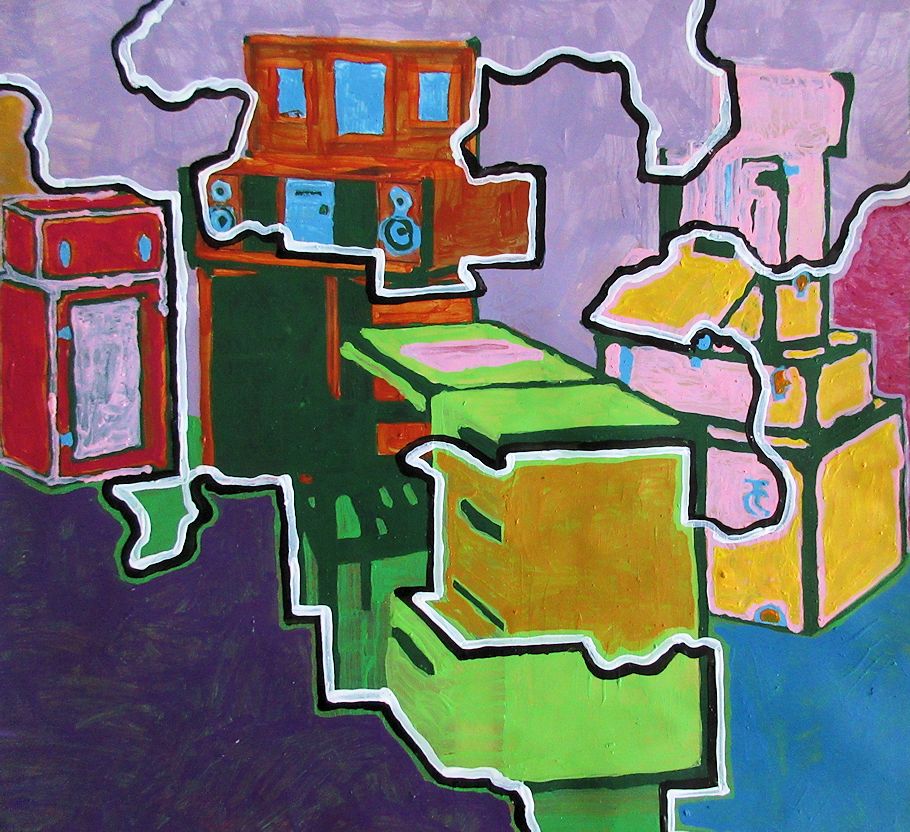
14 February 2023 Tuesday
Did Francesco do all the script etching? I.ve been wondering that for a number of months now. Does it mean anything if Francesco did do all the script etching (of the plates associated with his name)? For one thing, it would mean that he was very good at it, script etching, that is, for the is so much of it, a nimiety even.
Was it perhaps even Francesco who came up with the idea of excelling at script etching by training one's opposite writing hand to (simultaneously write as a mirror-image would have it?
Dimostrazione dell'Emissario del Lago di Fucino

Demonstration of the Emissary of Lake Fucino, in two tables to be assembled, title with index reported (G. B. Piranesi drawing and inc. etching; F. Piranesi inc. burin).
Ferdinand IV and Mar(ia) Carolina
To the God of the country and to the good arts from (nno) 1779
Collegiate Ferdinand
To the Majesty of Ferdinand IV.
King of the two Sicilies, and of Jerusalem &c. &c.
Fig. I. View of Lake Fucino, and its vicinity located in the Abruzzo Province of the Kingdom of Naples formerly de' Marsi.
A. Site where the mountain was pierced to drain the water of the lake.
B. Orifici de Pozzi, and scalar tunnels, which descended into the speco of the Emissary.
C. Remains of ancient Cerfenia near the mouth of the emissary on the river Liri.
D. Sources, which discharge into the lake.
E. Trasangua, today Trasacco.
F. Remains of the ancient Via Valeria.
G. Salto river, which originates under Verrechio, and hides underground, reborn in Tagliacozzo.
H. Remains of ancient Alba Cittą de' Marsi, Colony of the Romans, among which those of its Amphitheater can be seen.
I. Today's Via Valeria, which leads to Alba.
Fig II. Topography of Lake Fucino.
A. B. Underground management of the outfall cave.
C. Vestiges of ancient Cerfenia.
D. Fountains, or springs, which discharge into the lake.
E. Remains of ancient Valeria Cittą de' Marzi Colonia de' Romani.
F. Piconio River now known as the Fara.
G. Fornelo in today's S. Maria di Piediponte.
H. Modern emissary through which the water of the Liri river passes in Campi Palentini.
I. Nerfa Valley.
Fig. III. General plan of the Emissary, which demonstrates the underground route of the cave, from its mouth to the end of it.
A. Part of Lake Fucino.
B. Mouth of the Emissary shown grounded as it appeared in the month of September, of the year 1766 when it was drawn.
CD. Underground speco of the Emissary excavated in the mountain.
E. Outcome of the emissary on the Liri bed.
F. River Liri.
Fig.IV. Vertical section of the mountain along the speco dell'Emissario.
A. Surface of the lake according to its lower height.
B. Line of the plane of the lowest specus of the lake's water surface.
C. Mouth of the outlet.
O.D. Length of the outflow hole.
F. Wells perpendicular to the cave, which were used to extract the materials cut to form the aforementioned cave.
G. Oblique tunnels of communication with the speco dell'Emissario pe', which the Workers made their way to dig it, and still served them as aditi, and regresses.
H. Large scalar tunnel, which branches off into three tunnels, two of which communicate in the tunnel of the Emissary, and the third communicates with the other tunnel
I. from where one passed into the aforementioned tunnel.
K. Oblique tunnels, which communicate in the wells perpendicular to the specus of the Emissary.
L. Oblique tunnel, which communicates in the cave.
M. Outcome of the outflow on the Liri river.
N. Bed of the Liri river.
O. Bed of the aforementioned river formed by two mountains.
P. Ordinary water surface of the aforementioned river.
Fig.V. Section of part of the Lake, and of its Emissary showing the state of the bed and surface of the Lake as it appeared when it was drawn.
A. Portion of the lake, and its surface
B. Bed of the aforementioned of much grown.
C. Mouth of the emissary proved to be uninterrupted as seen in the aforementioned time.
D. Line of the plane of the lowest specus of the lake's water surface.
Fig.VI. Large-scale demonstration of the plan of the Emissary, which presents the ancient state of its mouth first, which was blocked and its outcome on the Liri river, remaining the length of the tunnel wrapped around the sign.
A. Portion of the lake.
B. Line of the edge of the lake as it appeared when drawn.
C. Lines indicating where the edge of the water, which formed the ancient crater of the lake, should have reached.
D.E. Palisade walls, which form an enclosure in front of the mouth of the Emissary.
F. Mouth of the emissary, which absorbed the water of the lake.
Cav. Gio Bat(t)i(st)a Piranesi engraved and etched 1779
|